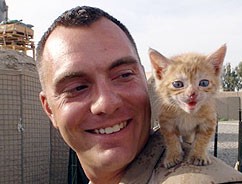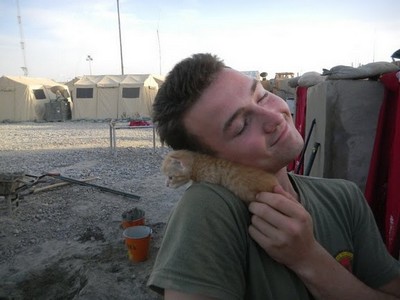It looks like you're using an Ad Blocker.
Please white-list or disable AboveTopSecret.com in your ad-blocking tool.
Thank you.
Some features of ATS will be disabled while you continue to use an ad-blocker.
share:
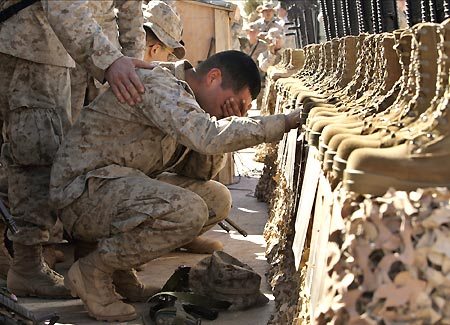
So there has been a lot of news lately about the dramatic and continuing rise of suicide rates in the military. And while many point to as the obvious cause the repeated deployments and the impact of significant physiological and psychological stress associated with a war zone...the truth is, no one seems to really know what's behind the numbers.
Last month set a record of the number of suicides in the US Army.
Suicide 'epidemic' in Army: July was worst month, Pentagon says
Even as the Afghanistan war winds down, suicides among troops are on the rise. Among all branches, the number is up 22 percent from a year ago, and July was the Army's worst month.
It is perhaps the greatest source of frustration and heartache within the US military, even as the war in Afghanistan winds down: the continuing rise of the suicide rate among troops.
July was the worst month on record since the Army began tracking suicide rates: 38 soldiers took their own lives, according to figures released Thursday by the Pentagon.
Trying to figure out how to arrest those numbers has been the ongoing quest of military officials for years.
Secretary of Defense Leon Panetta shared his frustration over the force’s inability to do so in June, during a suicide prevention conference that called for emphasizing the “mental fitness” of troops as ardently as their “physical fitness.”
Even so, Mr. Panetta lamented that military suicides “continue to move in a troubling and tragic direction.”
So far in 2012, the number of suicides among active-duty military personnel in all branches is up 22 percent compared with the same time last year. In 2011, a total of 301 troops took their lives. This year’s total may reach as many as one death per day from suicide.
“That is an epidemic,” Mr. Panetta told the House Armed Services Committee (HASC) last month.
“Something is wrong.”
Indeed, it is.
And despite the military's complete attention on the matter, the rates keep rising!
The rate of suicide remains twice as high as it was before the wars in Iraq and Afghanistan, so high that some have described the current situation as an epidemic. The increased rate commanded the attention of the highest military officers from all the branches of the service and the Department of Defense (DoD), and for the last five years or so, several ongoing, high-profile efforts have been made to better understand what may underlie these alarming statistics, and to determine how to prevent further suicides.
Source.
Returning to the first article quoted in this thread:
Today, suicide is the most frequent cause of death among Army forces, surpassing combat deaths and motor vehicle accidents, according to Gen. Raymond Odierno, the Army chief of staff. From 2004 to 2009, the suicide rate within the force doubled.
Amazing...
But part of the problem is the numbers themselves...or more specifically how they are distributed.
First, let's look at how they fall within the branch of services:
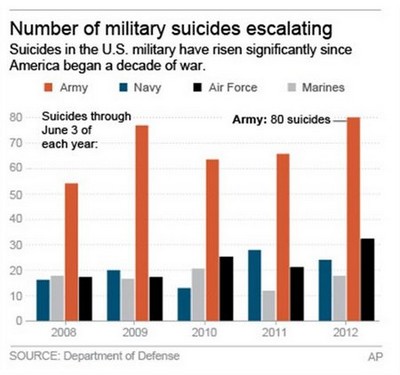
It's clear from the above graphic, the army has the biggest problem.
Here's a graphic showing the rate increases among the branches of service, in comparison to the general population over time:
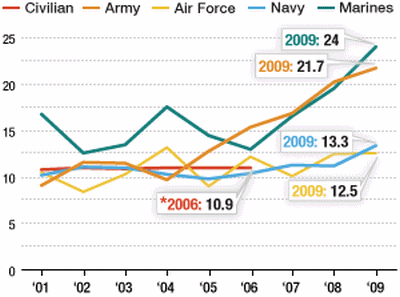
But despite the obvious conclusions one might discern from these numbers, what is also clear is that the numbers are moving in directions that diminish the likelihood of some explanations, while possibly over-emphasizing others.
For example, for the first time, there are more suicides among longer-serving non-commissioned officers than among young soldiers....The rate among veterans is higher than for active duty service members.
And then there are these items to consider:
The vast majority of service members who commit suicide do not have a documented or ascertainable major mental illness.
This conclusion is clearly not the case in the general population, where suicide is linked to major psychiatric disorders, especially depression and bipolar disorder.
...the data suggest that military suicides are more impulsive[//color] rather than linked to psychiatric disease.
Source.
Consider this also:
We have been at war for 10 years, with numerous deployments for many soldiers and units. But a surprising statistic has remained relatively constant over the last 7 years: about one-third of the soldiers who commit suicide have never deployed. Another third commit suicide during deployment, and one-third do so afterward.
Source.
In addition to the items above, other interesting statistics follow:
Significant rise in car accidents for returning military members
The USAA Property and Casualty Insurance Group, an organization that insures the families of military members, has concluded a three-year study of what impact overseas deployments have on U.S. military members when they get behind the wheel of a car.
...
What USAA discovered was an at-fault car accident rate that was 13% greater after returning from a deployment.
There was no evidence indicating an increase in fatal accidents, but returning military members seem to struggle with becoming reacquainted with the rules of the road in the U.S.
By branch, the at-fault accident rate most noticeably jumped for the Army, which saw a 23% rise. That was followed by the Marines (12.5%), and then the Navy (3%) and Air Force (2%). There were other varying factors: enlisted troops were more likely to cause an accident than officers, and the younger a military member was, the more likely they were to get into an accident (especially under the age of 22).
An interesting distribution, among the services, don't you think?
And this too:
Multiple deployments made the numbers worse. Drivers returning from a third deployment were 36% more likely to have an at-fault accident, compared with a 12% bump in at-fault accidents for drivers returning from first deployments.
Source.
So, what's my ATS SKUNK WORKS theory about a potential cause for the numbers?
These little guys:

In an article published this month in The Journal of Clinical Psychiatry, researchers made a troubling announcement:
Parasite Drives Some to Attempt Suicide
The parasite Toxoplasma gondii (T. gondii), long thought to be harmless, instead has been found to cause changes in the human brain so harmful that for some, they include attempts at suicide, a research team reports.
In a study published in this month’s issue of The Journal of Clinical Psychiatry, a team of researchers from the U.S., Sweden, and Egypt linked T. gondii to inflammation over time causes changes to the brain—namely the production of harmful metabolites that can damage brain cells.
Researchers discovered a seven-fold increase in nonfatal suicidal self-directed violence in people testing positive for T. gondii IgG antibodies compared with people who tested negative. The result is five times the increase associated with the parasite in previous studies that did not specifically focus on self-directed violence.[/url]
Worse, reported the researchers, the correlation with attempted suicide was specific to T. gondii antibodies as opposed to antibodies to other neurotropic organisms, such as CMV or HSV-1.
Toxoplasma gondii
Toxoplasmosis is a parasitic disease caused by the protozoan Toxoplasma gondii. The parasite infects most genera of warm-blooded animals, including humans, but the primary host is the felid (cat) family. The parasite spreads by the ingestion of infected meat or the feces of an infected cat, or by vertical transmission from mother to fetus. A 2001 study found that direct contact with pet cats is probably a less common route of transmission to human hosts than contamination of hands with cat feces by touching the earth, and that "contact with infected raw meat is probably a more important cause of human infection in many countries".
From one-third to half of the world's human population is estimated to carry a Toxoplasma infection. The Centers for Disease Control and Prevention notes that overall seroprevalence in the United States as determined with specimens collected by the National Health and Nutritional Examination Survey (NHANES) between 1999 and 2004 was found to be 10.8%, with seroprevalence among women of childbearing age (15 to 44 years) at 11%. Another study placed seroprevalence in the U.S. at 22.5%. The same study claimed a seroprevalence of 75% in El Salvador. A sample of 273 people in rural France was measured at 47% prevalence.
During the first few weeks after exposure, the infection typically causes a mild, flu-like illness or no illness. Thereafter, the parasite rarely causes any symptoms in otherwise healthy adults. However, those with a weakened immune system, such as AIDS patients or pregnant women, may become seriously ill, and it can occasionally be fatal. The parasite can cause encephalitis (inflammation of the brain) and neurologic diseases, and can affect the heart, liver, inner ears, and eyes (chorioretinitis). Recent research has also linked toxoplasmosis with brain cancer, attention deficit hyperactivity disorder, obsessive compulsive disorder, and schizophrenia.
The obvious implication is that maybe these little buggers have something to do with the suicide and accident rate in the military.
Surprisingly, there have been very few studies actually conducted on the distribution of these parasites around the world.
It's not even very clear how transmission of the parasite most frequently occurs, or which ones are most important. The CDC produces the following graphic of the most prevailing thought on subject:
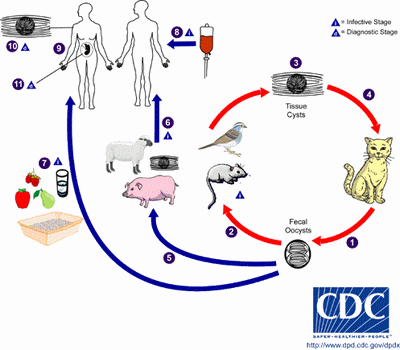
Then there is this excellent study on the matter:
Toxoplasmosis is one of the more common parasitic zoonoses world-wide. Its causative agent, Toxoplasma gondii, is a facultatively heteroxenous, polyxenous protozoon that has developed several potential routes of transmission within and between different host species. If first contracted during pregnancy, T. gondii may be transmitted vertically by tachyzoites that are passed to the foetus via the placenta. Horizontal transmission of T. gondii may involve three life-cycle stages, i.e. ingesting infectious oocysts from the environment or ingesting tissue cysts or tachyzoites which are contained in meat or primary offal (viscera) of many different animals. Transmission may also occur via tachyzoites contained in blood products, tissue transplants, or unpasteurised milk. However, it is not known which of these routes is more important epidemiologically. In the past, the consumption of raw or undercooked meat, in particular of pigs and sheep, has been regarded as a major route of transmission to humans. However, recent studies showed that the prevalence of T. gondii in meat-producing animals decreased considerably over the past 20 years in areas with intensive farm management. For example, in several countries of the European Union prevalences of T. gondii in fattening pigs are now 14 d, 9.8%), or chronic symptoms (>30 d, 3.3%). Diarrhea was associated with time spent off military compounds and eating local food. Over 80% of respondents sought care for their symptoms, usually at the lowest echelon of care (field medic), and were most often treated with either loperamide or an antibiotic. Self-treatment with loperamide or Pepto-Bismol was also common and successful with only 9% of self-treated individuals reporting seeking further medical care.
CONCLUSIONS:
Infectious diarrhea is a common problem for US military personnel, and associated fevers and vomiting are more common than in past conflicts in the region. As with past studies, time spent off base and local food consumption, both more common in Iraq than Afghanistan, continue to be the most important risk factors for acquiring diarrhea. The majority of soldiers reported seeking care for diarrhea, but appropriate treatment, including self-treatment with over-the-counter medicines, was generally successful. Further studies should be conducted to evaluate appropriate treatment algorithms, including the use of self-treatment, for deployed military personnel.
Source
I'm not done.
Another interesting thing about the overall suicide numbers is that many of these people sought some sort of clinical treatment (unrelated to suicidal behavior) in advance of their actions.
For example:
Health care experiences prior to suicide and self-inflicted injury, active component, U.S. Armed Forces, 2001-2010.
We summarized the outpatient experiences of service members prior to suicide or self-inflicted injury and compared them with service members without suicidal behavior. During 2001-2010, 45 percent of individuals who completed suicide and 75 percent of those who injured themselves had outpatient encounters within 30 days prior to suicide/self-harm. Primary care was the most frequently visited clinical service prior to suicide/self-harm. As compared to their counterparts, service members with suicidal behavior had especially excessive outpatient visit rates within, but not prior to, 60 days of their deaths/injuries.
AND:
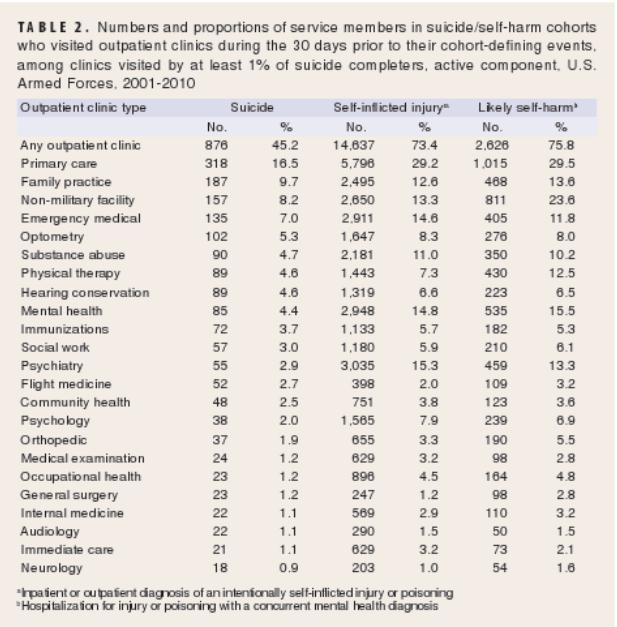
Source.
Notice where the items fall?
Even the optometry number is fascinating.
Ocular toxoplasmosis is a type of inner eye infection. It is a leading cause of retinochoroiditis in the United States. Retinochoroiditis affects the retina, located at the back of the eye, and the choroid, its blood supply.
Ocular toxoplasmosis is a condition that develops in some people after toxoplasmosis parasite infection. The infection may be transmitted because of contamination, or it may be transmitted from an infected mother to a baby during pregnancy. People with suppressed immune systems are the most vulnerable to the effects of toxoplasmosis.
Toxoplasmosis can cause blurred vision, mild eye pain, and lead to vision loss.
Source
I think you now see where this is headed...
So let's see what we find that supports this theory in Afghanistan...
First, here is one study on the prevalence of Toxoplasmosis infections in animals in Afghanistan:
The authors investigated a total of 435 domestic animals in Afghanistan by micromodification of indirect hemagglutination test. Camels showed the highest incidence of infection (73.7%). Of 9 zebu 3 were positive. The incidence of infection in goats was 31.6%, in sheep 20.4%, in buffaloes 20.4%. The lowest percentages of positive titres was detected in cattle (15.7).
Now think about this...
These troops are deployed to areas where it seems certain their daily exposure to this parasite is greater than would otherwise occur domestically.
These soldiers work, sleep, play and eat in ways that implicate an increased possibility of exposure.
Still not convinced this is worth considering?
Look at some of these items:
And:
Bases going to the dogs - and cats
U.S. soldiers and Marines are smuggling them onto bases across the country.
The military leadership seems to turn a blind eye, though regulations specifically prohibit them.
They go by names like Smoke, Bacon, Mickey Blue Eyes and Butterscotch, and they can be coerced with as little as a pat on the head, a scratch behind the ears or a tasty treat.
They are the stray dogs and cats of Afghanistan who, at many — if not most — U.S. bases here are adopted by soldiers and Marines individually, by squad or platoon, and spoiled as much as any mutts or felines in suburban America.
While no one will say so officially, it appears commanders recognize the value that pet dogs and cats bring to the morale of a base, so they look the other way as long as the animals do not interfere with the mission or present health concerns.
You might call it a policy of don’t bark, don’t smell.
“It is common in both Iraq and Afghanistan for units to adopt local dogs and cats,” said SPCA International spokeswoman Stephanie Scott. “We have been told time and time again that these dogs and cats can be of great comfort and a little piece of home to our troops.”
...
At an outpost adjacent to the Afghan National Police headquarters in the Garmsir district of Helmand province, the U.S. Marines in recent months launched a catnapping mission during which two felines were taken from nearby Forward Operating Base Delhi for the purpose of taking care of the outpost’s mice problem.
Weeks later, the mice were gone but the cats remained as the constant objects of affection and, at one point, a spirited discussion among the Marines about which had the more interesting personality traits and habits.
“They’re more like dogs than cats,” one Marine said, as if bragging about his children.
--------------
In Afghanistan, in the midst of war, many animals are lost and separated from their family. Many are found later by troops from the US, UK and Canada. Soldiers rescue these animals and get help from rescue groups that help them send these animals out of the country and to a forever loving home that they deserve.
Source.
Interesting, isn't it?
And let's consider other environmental exposure factors, like this:
Marines endure fleas, flies, filth in Marjah
By any estimate, the living conditions at Combat Outpost Coutu can only be described as grim.
..
There are no beds, no showers, no toilets and no electricity. Chickens and ducks roam the bare dirt yard amid scraps of trash and rotting animal dung. Fleas, flies and filth are the grunts’ constant companions.
...
Until recently, the Marines of Company L ate only prepackaged Meals, Ready to Eat. But once they moved into the compound, supply helicopters dropped off boxes of Gatorade, juices, potato chips and power bars. Hot food is a rare commodity. An Army Stryker unit that pulled out of the area in early March left behind a stack of self-heating tins of Szechuan chicken, corned beef hash, boiled ham, cream beef and biscuits, but the food will soon be gone. Occasionally, the Afghan army company the Marines are partnered with invites them over for rice and lamb.
At night, the men sleep on camping mats and in sleeping bags or rolled up in bivouac sacks on the hard-packed dirt of the compound’s few available rooms. But the fleas and chiggers are often so bad that some Marines sleep outside instead.
Garbage and waste are disposed of in a large burn pit that a squad of Marines recently dug out by hand.
The only running water comes from an old-fashioned hand pump in the middle of the yard. If a Marine wants a shower, he has to fill up a large rubber bag and wait for the sun to heat the water, but it’s such a hassle that hardly anyone bothers. Most of them haven’t had a proper bath since before the Marjah operation started more than a month ago. They rely on baby wipes instead.
They wash their clothes at the pump, too, filling a large bowl or ammo can with water, throwing in a bar of soap, and working out the dirt by hand.
See also: U.S. military goes hungry in Afghanistan
Do you think that likely drives up their consumption of locally available food items- particularly goat and lamb, which have high infection rates?
In fact, take a look at this:
US special forces to be taught how to cook for Afghan tribal elders
United States Special Operation Command is looking for butchers and cooks who can teach how to slaughter livestock, then prepare a meal.
It wants its commandos to learn to prepare an "Afghan meal cooked in the style and presentation that would be expected by local village elders", according to procurement documents.
The documents do not detail why the soldiers will be taught to cook, but special forces teams in Afghanistan frequently live among remote villages where they raise and train local defence forces to resist the Taliban.
Sharing cups of green tea, meals and hospitality with locals has long been considered critical to Nato's "hearts and minds" counter insurgency campaign.
...
The three-day Afghanistan Cooking Techniques course will teach up to 132 soldiers in bases including Fort Lewis, Eglin Air Force Base and Fort Bragg.
Pupils will learn to slaughter cattle, sheep and goats according to Islamic principles and "how to process and cure meats and vegetables in a culturally sensitive environment".
As well as cooking, they will be taught to identify cuts of meat, how to preserve animal hides and cooked materials, and even how to bake bread from raw wheat kernels.
All cooking will be done with "indigenous cooking equipment". The trainee chefs will finish the course with a written test.
Very, very interesting... No?
So there you have it.
Perhaps it's a coincidental overlap, or maybe this really hits on something.
I look forward to seeing whether others might think this theory is worth looking into. Whatever the cause, our troops deserve our full attention on this growing problem.
edit on 19-8-2012 by loam because: (no reason given)
Very well documented, researched, and debated piece.
Well done!
I started reading with my own (admitted) biases regarding speculation toward the causes of suicide relative my experiences concerning the civilian spectrum, but, your data and argument have me on your side.
I will hold out, however, that it may not be as simple as one single culprit, but, several factors rolled together in creating the perfect storm scenario for each troubled soldier.
S&F!
Well done!
I started reading with my own (admitted) biases regarding speculation toward the causes of suicide relative my experiences concerning the civilian spectrum, but, your data and argument have me on your side.
I will hold out, however, that it may not be as simple as one single culprit, but, several factors rolled together in creating the perfect storm scenario for each troubled soldier.
S&F!
reply to post by loam
After that read I see why you are an ATS SME.
Brilliantly researched and near on impossible to dismiss as the most likely cause of these suicides.
I'll go with your theory here mate.
S&F.............and if I could give you more I would. Individuals such as yourself are the reason I joined ATS in the first place
Again - thank you.
After that read I see why you are an ATS SME.
Brilliantly researched and near on impossible to dismiss as the most likely cause of these suicides.
I'll go with your theory here mate.
S&F.............and if I could give you more I would. Individuals such as yourself are the reason I joined ATS in the first place
Again - thank you.
Well, my edit window has elapsed.
But you get the idea.
Apologies for the typos and errors. It's too late for me to fix them now.
But you get the idea.
Apologies for the typos and errors. It's too late for me to fix them now.
reply to post by loam
To get fully conspiratorial in the spirit of these boards, I offer this thread:
ATS THREAD: The Army Has Issued Anti-Suicide Nasal Spray
What's interesting about that is the same Indiana University that received funding for the nasal spray research, also seems to be rather relevant in the toxoplasmosis research world.
Toxoplasma Research Offers Potential for a Range of Benefits
And:
Indiana U scientists uncover potential key to better drugs to fight toxoplasmosis parasite
Hmmmm.....
To get fully conspiratorial in the spirit of these boards, I offer this thread:
ATS THREAD: The Army Has Issued Anti-Suicide Nasal Spray
What's interesting about that is the same Indiana University that received funding for the nasal spray research, also seems to be rather relevant in the toxoplasmosis research world.
Toxoplasma Research Offers Potential for a Range of Benefits
And:
Indiana U scientists uncover potential key to better drugs to fight toxoplasmosis parasite
Hmmmm.....
reply to post by Druscilla
First, thank you.
And I quite agree there may be many factors. But a pathogen as a possible cause doesn't seem to be on the radar... Or maybe it is. (See my post above.)
What is clear is that a compromised immune system, including extreme stress, seems to make some people more acutely affected by the symptoms of toxoplasmosis than others.
Then there is this interesting tidbit, I keep think about:
Upon further reading it turns out there is another revealing possibility involving that third of the population:
The researcher continues:
Hmmmmm. Why would that be?
He goes on:
Now, he concludes various reasons for this association.
But I can't help but notice this still sounds very much like pathogenic transmission between individuals- those who deploy to Iraq or Afghanistan frequently and those who don't and still either attempt to kill themselves or manage to do it.
reply to post by Sublimecraft
Thank you! I'm glad you liked the read.
Originally posted by Druscilla
Very well documented, researched, and debated piece.
Well done!
I started reading with my own (admitted) biases regarding speculation toward the causes of suicide relative my experiences concerning the civilian spectrum, but, your data and argument have me on your side.
I will hold out, however, that it may not be as simple as one single culprit, but, several factors rolled together in creating the perfect storm scenario for each troubled soldier.
S&F!
First, thank you.
And I quite agree there may be many factors. But a pathogen as a possible cause doesn't seem to be on the radar... Or maybe it is. (See my post above.)
What is clear is that a compromised immune system, including extreme stress, seems to make some people more acutely affected by the symptoms of toxoplasmosis than others.
Then there is this interesting tidbit, I keep think about:
But a surprising statistic has remained relatively constant over the last 7 years: about one-third of the soldiers who commit suicide have never deployed.
Source.
Upon further reading it turns out there is another revealing possibility involving that third of the population:
The researcher continues:
...[It's] the unit’s deployment history, rather than the individual’s deployment history, that contributes the most to suicide risk.
Hmmmmm. Why would that be?
He goes on:
The installations with the highest suicide rates are often those with the highest deployment op-tempo (operations tempo). High op-tempo refers to rapid movement both in and out of the theater of war and back and forth to training. Units based at installations like Fort Campbell, Fort Carson, Fort Stewart, Fort Hood, and Fort Riley have frequently deployed to Iraq and Afghanistan, some as often as every other year, since 2003. Even when these units are supposedly “home,” the soldiers may still be working long, intense hours, preparing and training for the next deployment. I have been part of teams investigating all of these bases with escalating suicide rates. Over and over commanders told me, “This high op-tempo means I do not know my soldiers. There used to be all sorts of ways to incorporate a soldier into a unit—picnics, runs, and barbecues. Now we are all too busy preparing for the next deployment.”
Now, he concludes various reasons for this association.
But I can't help but notice this still sounds very much like pathogenic transmission between individuals- those who deploy to Iraq or Afghanistan frequently and those who don't and still either attempt to kill themselves or manage to do it.
reply to post by Sublimecraft
Originally posted by Sublimecraft
Individuals such as yourself are the reason I joined ATS in the first place
Again - thank you.
Thank you! I'm glad you liked the read.
edit on 19-8-2012 by loam because: (no reason given)
One additional study I intended to include, came from Prague.
Increased incidence of traffic accidents in Toxoplasma-infected military drivers and protective effect RhD molecule revealed by a large-scale prospective cohort study
Latent toxoplasmosis, protozoan parasitosis with prevalence rates from 20 to 60% in most populations, is known to impair reaction times in infected subjects, which results, for example, in a higher risk of traffic accidents in subjects with this life-long infection.
...
Results
We confirmed, using for the first time a prospective cohort study design, increased risk of traffic accidents in Toxoplasma-infected subjects and demonstrated a strong protective effect of RhD positivity against the risk of traffic accidents posed by latent toxoplasmosis. Our results show that RhD-negative subjects with high titers of anti-Toxoplasma antibodies had a probability of a traffic accident of about 16.7%, i.e. a more than six times higher rate than Toxoplasma-free or RhD-positive subjects.
Conclusion
Our results showed that a common infection by Toxoplasma gondii could have strong impact on the probability of traffic accident in RhD negative subjects.
A well researched thread however at the forefront of my mind is the fact the soldiers are humans and at some point they realise they are killing other
humans - and they question the morality of their actions.
Theorising is supposition - you are supposing something is a problem. What about what the soldiers are viewing with their own eyes? Let's leave the animals and bacteria out of the theory for a moment - let's look at the war!!!!!
A young woman/man goes to war after being told repeatedly that she/he is fighting for their country and the for the good of their people etcetera. The soldier then shoots at human beings - the human beings are sometimes very young - sometimes they are unarmed - sometimes they are just going about their day minding their own business - but - the soldier shoots them because that is their job.
At some point the soldier is going to think about all the people they have killed - for what purpose - and the psychological agony is enough to drive them to suicide. Soldiers are waking up and for them the awakening process is going to be incredibly painful - because - they pulled the trigger to kill. Living with the thought that they have killed Children and innocent people - that would be enough to drive me to suicide.
I hope all the soldiers wake up and support each other in the process. The american government is worried that they will not have enough to soldiers to fight their political wars for them. So - leave the defenceless animals and bacteria out of the argument - just for a moment and like a thorough scientist - look at every aspect of what is occurring. Animals and bacteria are everywhere - all over the planet - soldiers committing suicide ... I do not believe that bacteria from a kitten is going to drive a soldier to suicide - nightmares, persistent thoughts and visions of the people she/he has slaughtered - that would be enough to drive anyone to suicide.
Much Peace...to everyone on this planet ...
Theorising is supposition - you are supposing something is a problem. What about what the soldiers are viewing with their own eyes? Let's leave the animals and bacteria out of the theory for a moment - let's look at the war!!!!!
A young woman/man goes to war after being told repeatedly that she/he is fighting for their country and the for the good of their people etcetera. The soldier then shoots at human beings - the human beings are sometimes very young - sometimes they are unarmed - sometimes they are just going about their day minding their own business - but - the soldier shoots them because that is their job.
At some point the soldier is going to think about all the people they have killed - for what purpose - and the psychological agony is enough to drive them to suicide. Soldiers are waking up and for them the awakening process is going to be incredibly painful - because - they pulled the trigger to kill. Living with the thought that they have killed Children and innocent people - that would be enough to drive me to suicide.
I hope all the soldiers wake up and support each other in the process. The american government is worried that they will not have enough to soldiers to fight their political wars for them. So - leave the defenceless animals and bacteria out of the argument - just for a moment and like a thorough scientist - look at every aspect of what is occurring. Animals and bacteria are everywhere - all over the planet - soldiers committing suicide ... I do not believe that bacteria from a kitten is going to drive a soldier to suicide - nightmares, persistent thoughts and visions of the people she/he has slaughtered - that would be enough to drive anyone to suicide.
Much Peace...to everyone on this planet ...
reply to post by Amanda5
I hear your point.
However, the data says something potentially very different:
That is inconsistent with the mainstream impression of this problem.
I hear your point.
However, the data says something potentially very different:
While many expected the data to show that frequent deployments could be linked to suicide risk, the data did not support that theory, as 79 percent of the suicides recorded by the Army in fiscal year 2009 were soldiers who had completed only a single deployment or had not deployed at all.
Source.
That is inconsistent with the mainstream impression of this problem.
reply to post by loam
Okay let's consider the fact that soldiers speak with one another - a soldier does not have to have seen active combat to be driven to suicide. Let's consider the fact that at enlistment a soldier signs away a period of her/his life and is locked into a legally binding contract.
A soldier - locked into a contract - has not yet seen active combat - speaks directly to other active soldiers and/or hears news reports and other information and realise that killing innocent people is not what she/he signed up for - well suicide might seem like a logical escape route at the time.
Who compiles the data that you cite? How controlled is the data? How many participants contributed to the data? Just remember that 6 people (CEOs) control all information that is directed at the public and that includes textbooks and scientific journals.
Soldiers commit suicide because the psychological conditioning of their training wears off - they awaken - the awakening is sooooo painful they cannot cope because they cannot undo what they have done. Combined with the fact they are locked into an enlistment contract....
I am still choosing to utilise my own intellect - after reading the references I still don't see a complete picture - I see human beings committing suicide because they do not see a way out of what they have done - of what they are about to do - and because they realise they are fighting a war that is about politics and politicians - not about protecting their people.
Suicide is often referred to as a signal for help. Soldiers are committing suicide because they are not getting the help they need - to stop killing and/or to be released from their enlistment contract. Reading "studies' and 'research' is a great way to have your thoughts and opinions shaped by those who write and control the 'studies' and 'research." As an advanced maths Student stated to me recently - Miss all science is theory to which I replied and the money trail will show you which theory is making it to the people.
Much Peace...it looks as if the American soldiers could do with a huge helping...
Okay let's consider the fact that soldiers speak with one another - a soldier does not have to have seen active combat to be driven to suicide. Let's consider the fact that at enlistment a soldier signs away a period of her/his life and is locked into a legally binding contract.
A soldier - locked into a contract - has not yet seen active combat - speaks directly to other active soldiers and/or hears news reports and other information and realise that killing innocent people is not what she/he signed up for - well suicide might seem like a logical escape route at the time.
Who compiles the data that you cite? How controlled is the data? How many participants contributed to the data? Just remember that 6 people (CEOs) control all information that is directed at the public and that includes textbooks and scientific journals.
Soldiers commit suicide because the psychological conditioning of their training wears off - they awaken - the awakening is sooooo painful they cannot cope because they cannot undo what they have done. Combined with the fact they are locked into an enlistment contract....
I am still choosing to utilise my own intellect - after reading the references I still don't see a complete picture - I see human beings committing suicide because they do not see a way out of what they have done - of what they are about to do - and because they realise they are fighting a war that is about politics and politicians - not about protecting their people.
Suicide is often referred to as a signal for help. Soldiers are committing suicide because they are not getting the help they need - to stop killing and/or to be released from their enlistment contract. Reading "studies' and 'research' is a great way to have your thoughts and opinions shaped by those who write and control the 'studies' and 'research." As an advanced maths Student stated to me recently - Miss all science is theory to which I replied and the money trail will show you which theory is making it to the people.
Much Peace...it looks as if the American soldiers could do with a huge helping...
reply to post by Amanda5
I understand what you say is the likely cause.
But I also understand what the data says...or doesn't say.
Where does the data come from? The only place it can. The military and other government agencies or government funded institutions. So what?
It's hardly flattering data, so why would they monkey around with it, when miliions of dollars are being spent addressing the very possibilities you suggest.
Look, it's not like there isn't a biological precedent for parasites to alter behavior. Just look at these ATS threads and their sources:
And as I've already mentioned, maybe it's a combination of the stress of a war environment and a pathogen.
Or maybe even the very campaigns focused on educating the troops about this problem...and all of the media coverage...have something to do with it too.
Werther Effect
And:
Maybe it's all three.
I understand what you say is the likely cause.
But I also understand what the data says...or doesn't say.
Where does the data come from? The only place it can. The military and other government agencies or government funded institutions. So what?
It's hardly flattering data, so why would they monkey around with it, when miliions of dollars are being spent addressing the very possibilities you suggest.
Look, it's not like there isn't a biological precedent for parasites to alter behavior. Just look at these ATS threads and their sources:
Parasites brainwash grasshoppers into death dive
Mushrooms That Take Over Their Victims' Minds
Fly Parasite Turns HoneyBees into ZomBees
5 Real Diseases That Could Make You Act Just Like A Real Zombie
And as I've already mentioned, maybe it's a combination of the stress of a war environment and a pathogen.
Or maybe even the very campaigns focused on educating the troops about this problem...and all of the media coverage...have something to do with it too.
Werther Effect
The Werther Effect is a term coined by American sociologist Dave Phillips in 1974 to describe the phenomenon that behaviors, whether self-preservative or destructive, are copied between humans by ideas manifested in language (ex: literature, music), in addition to genetics. Named after the protagonist in The Sorrows of Young Werther, this observation is closely associated with “contagious human behaviors”, including multiple personality disorder, pathological homesickness and suicide.
And:
The Werther effect reconsidered in light of psychological vulnerabilities: Results of a pilot study
Findings from three decades of epidemiological studies suggest that media diffusion of stories about suicide is related to increases in suicidal behaviours in the population exposed to the media reports. However, we still know little about the psychological processes and personal vulnerabilities that prompt some people to engage in suicidal behaviours after exposure to media presentations of suicides. This cross-sectional study explored the possible impact of exposure to film suicide in normal young people.
...
Of the 101 participants, 70% reported being distressed by the portrayal of a suicide in a fictional film. Among those, 33% stated they felt distressed about the portrayal for several days to several weeks. The majority of the affected participants (71%) indicated having been mentally preoccupied for some time by the portrayal and experienced intrusive memories (68%). Emotional reactivity and dissociation tendencies were significant predictors of the negative reactions to the suicide film they viewed. Participants who reported that the idea had crossed their mind to imitate the suicidal protagonist in the film were 3.45 times more likely to be suicidal and tended to present higher dissociation and thought suppression propensities compared to those who did not report these thoughts.
...
Results suggest that fictional suicide portrayals in the media may have a deleterious impact on viewers, and such impacts do not appear to be limited to people having a clinical profile of mental disorders, as previously assumed by researchers in the field.
Maybe it's all three.
edit on 19-8-2012 by loam because: (no reason given)
We need a list of all of the suicides of active duty US and Canadian military personell in the last 24 mths,and we need to assign rank to each
name,location of hometown,training and deployment locations and any affiliations we can identify.
This could be a "housecleaning"before a civil engagement,a final swath to ease control transition.Beware of a dynamic change in balance of power.
This could be a "housecleaning"before a civil engagement,a final swath to ease control transition.Beware of a dynamic change in balance of power.
I believe that the the increase in suicides is due to the military using this as an opportunity to create "ghost" operatives. The mental strain and
repeat deployments have caused a high number of individuals to end up with signs of depression including suicidal thoughts.
I think it's the age. The average age is 18-22. At that age they're still innocent and don't have the cooping mechanisms of an older adult. So when
they're exposed to mass trama they can't handle it and snap. Not to mention, sleep deprevation, getting screemed at, intense training, tons of
experimental drugs, and other harsh conditions. .
edit on 20-8-2012 by r2d246 because: (no reason given)
reply to post by r2d246
From one of my sources above:
So age doesnt explain it alone.
From one of my sources above:
The demographics are also changing. For the first time, there are more suicides among longer-serving non-commissioned officers than among young soldiers.
So age doesnt explain it alone.
edit on 20-8-2012 by loam because: (no reason given)
reply to post by loam
Wonderful read Loam. If I may...
Imagine being young, impressionable, trained to kill, and finding out (either before or after) that the cause is unjust and that you are really just a paid murderer. Imagine if in fact the danger to your soul becomes the higher priority over obeying orders and yet there is no way out from the dilemma. A choice must be made. The realization of the immorality of acts of an unjust war (is there any other kind?) with the most murderous weapons ever known to humankind.
In WWII the average combat experienced by an infantry soldier was one week out of a year. I heard that recently and thought it understated but it did say average. I can't find the link. Vietnam vets had to deal with two years in country and 1 year combat zone deployment. Even than it was "mission" oriented and not extended stay where there is no relief. There is no "behind the lines" in Afghanistan, for instance.
Being "new" and hearing about it from others before deployment (grunts don't lie to each other), facing repeated redeployments with no end in sight, and experiencing the futility of a winless and bloody conflict firsthand for longer than any other units in American history. Add prescribed drugs and any alcohol dependancy to this overall PTSD effect and I think it should become clearer. Overall, adding up all the carnage, lengthy stays and misguided goals or strategy has got to wear on individuals to the breaking point.
Mass murderers have this propensity of killing a bunch of people and then themselves soon after. I am not saying troops are mass murderers, but that they can be exposed to mass death they may have been involved in, in the name of war, that has the same result on their psyche. Seeing what they have wrought with modern weapons must be traumatizing... I don't care how hard core you think you are.
Wonderful read Loam. If I may...
Then there is this interesting tidbit, I keep think(ing) about:
But a surprising statistic has remained relatively constant over the last 7 years: about one-third of the soldiers who commit suicide have never deployed.
Imagine being young, impressionable, trained to kill, and finding out (either before or after) that the cause is unjust and that you are really just a paid murderer. Imagine if in fact the danger to your soul becomes the higher priority over obeying orders and yet there is no way out from the dilemma. A choice must be made. The realization of the immorality of acts of an unjust war (is there any other kind?) with the most murderous weapons ever known to humankind.
In WWII the average combat experienced by an infantry soldier was one week out of a year. I heard that recently and thought it understated but it did say average. I can't find the link. Vietnam vets had to deal with two years in country and 1 year combat zone deployment. Even than it was "mission" oriented and not extended stay where there is no relief. There is no "behind the lines" in Afghanistan, for instance.
Being "new" and hearing about it from others before deployment (grunts don't lie to each other), facing repeated redeployments with no end in sight, and experiencing the futility of a winless and bloody conflict firsthand for longer than any other units in American history. Add prescribed drugs and any alcohol dependancy to this overall PTSD effect and I think it should become clearer. Overall, adding up all the carnage, lengthy stays and misguided goals or strategy has got to wear on individuals to the breaking point.
Mass murderers have this propensity of killing a bunch of people and then themselves soon after. I am not saying troops are mass murderers, but that they can be exposed to mass death they may have been involved in, in the name of war, that has the same result on their psyche. Seeing what they have wrought with modern weapons must be traumatizing... I don't care how hard core you think you are.
Don't forget about Bradley Manning - a soldier who blew the whistle on what was really happening. I imagine soldiers - whether young and naive or
older longer serving soldiers - see what has happened to Bradley Manning and just want out - suicide is the only option when you cannot escape the
situation.
Bradley Manning is a hero and he is the bravest soldier because he used the most powerful weapon there is - the truth - he stepped outside the established culture and spoke out. The government have him locked away where he cannot speak anymore - but that won't work - the truth is out and people know and people are concerned and asking questions about - everything!!
Soldiers committing suicide is a scream for help - the soldiers are not feeling as though they are being honourable human beings who signed up to help their country. The soldiers can see the truth and as for the nasal spray - that will wear off and the truth will still be evident.
Soldiers who live with the memory of blowing up Children and their families need more than a nasal spray - they need time to get their head and conscience around what they are a part of - political war that makes money for the politicians.
Blame the weather, food additives, kittens, bacteria, bacteria filled kittens, whatever you like - psychopaths, sociopaths and narcissists are liars and will never take the blame for their actions - never - they are not like regular human beings. Psychcopaths, sociopaths and narcissists will blame a kitten, the weather crikey they will blame santa claus if they thought they could get away with it!!
Much Peace...to all the soldiers everywhere who struggle to cope once they are in the awakened state...
Bradley Manning is a hero and he is the bravest soldier because he used the most powerful weapon there is - the truth - he stepped outside the established culture and spoke out. The government have him locked away where he cannot speak anymore - but that won't work - the truth is out and people know and people are concerned and asking questions about - everything!!
Soldiers committing suicide is a scream for help - the soldiers are not feeling as though they are being honourable human beings who signed up to help their country. The soldiers can see the truth and as for the nasal spray - that will wear off and the truth will still be evident.
Soldiers who live with the memory of blowing up Children and their families need more than a nasal spray - they need time to get their head and conscience around what they are a part of - political war that makes money for the politicians.
Blame the weather, food additives, kittens, bacteria, bacteria filled kittens, whatever you like - psychopaths, sociopaths and narcissists are liars and will never take the blame for their actions - never - they are not like regular human beings. Psychcopaths, sociopaths and narcissists will blame a kitten, the weather crikey they will blame santa claus if they thought they could get away with it!!
Much Peace...to all the soldiers everywhere who struggle to cope once they are in the awakened state...
Interesting,
I studied vetinary at college and covered most zoonotic diseases, never heard of Toxiplasmi Gondii causing suicidal thoughts in humans,
I highly doubt its the cause of the Army suicides however,
Afterall, wouldn't vets be suffering the most?
I studied vetinary at college and covered most zoonotic diseases, never heard of Toxiplasmi Gondii causing suicidal thoughts in humans,
I highly doubt its the cause of the Army suicides however,
Afterall, wouldn't vets be suffering the most?
edit on 20-8-2012 by Sinny because: (no reason given)
I was under the impression that this kind of infection clears up on its own if you do not have a weakened immune system. Maybe our troops suffer of
a weakened immune system because of all the radiation they are exposed to.
wouldn't this be more of a hypothesis than a theory ?
wouldn't this be more of a hypothesis than a theory ?
edit on 20-8-2012 by votan because: (no reason given)
Excellent read! I actually attended the Indiana School for the Blind for a few years in high school, where I knew around 4 people who lost their
vision due to infection of Toxoplasmosis. I immediately got rid of my cat. It is like eating fast food and trusting others with preparation of your
food, except I can control whether or not I am around cat boxes. I am currently going to I.U. and I have to say they are on the the cuting edge of
science, although their observatory sucks. lol SF, I must say that your theory is very plausible.
reply to post by loam
reply to post by loam
new topics
-
Don't cry do Cryo instead
General Chit Chat: 4 hours ago -
Tariffs all around, Except for ...
Predictions & Prophecies: 6 hours ago -
Gen Flynn's Sister and her cohort blow the whistle on DHS/CBP involvement in child trafficking.
Whistle Blowers and Leaked Documents: 11 hours ago
top topics
-
Trump sues media outlets -- 10 Billion Dollar lawsuit
US Political Madness: 17 hours ago, 25 flags -
Bucks County commissioners vote to count illegal ballots in Pennsylvania recount
2024 Elections: 16 hours ago, 23 flags -
Fired fema employee speaks.
US Political Madness: 17 hours ago, 10 flags -
Gen Flynn's Sister and her cohort blow the whistle on DHS/CBP involvement in child trafficking.
Whistle Blowers and Leaked Documents: 11 hours ago, 8 flags -
Don't cry do Cryo instead
General Chit Chat: 4 hours ago, 4 flags -
Anybody else using Pomodoro time management technique?
General Chit Chat: 13 hours ago, 3 flags -
Tariffs all around, Except for ...
Predictions & Prophecies: 6 hours ago, 3 flags
active topics
-
Tariffs all around, Except for ...
Predictions & Prophecies • 11 • : Dalamax -
How can you defend yourself when the police will not tell you what you did?
Posse Comitatus • 84 • : bastion -
Oligarchy It Is Then
Short Stories • 14 • : UKTruth -
Don't cry do Cryo instead
General Chit Chat • 1 • : angelchemuel -
Mike Tyson returns 11-15-24
World Sports • 54 • : angelchemuel -
President-Elect DONALD TRUMP's 2nd-Term Administration Takes Shape.
Political Ideology • 205 • : WeMustCare -
On Nov. 5th 2024 - AMERICANS Prevented the Complete Destruction of America from Within.
2024 Elections • 155 • : WeMustCare -
The Trump effect 6 days after 2024 election
2024 Elections • 143 • : cherokeetroy -
Bucks County commissioners vote to count illegal ballots in Pennsylvania recount
2024 Elections • 21 • : Irishhaf -
60s-70s Psychedelia
Music • 54 • : gort69


